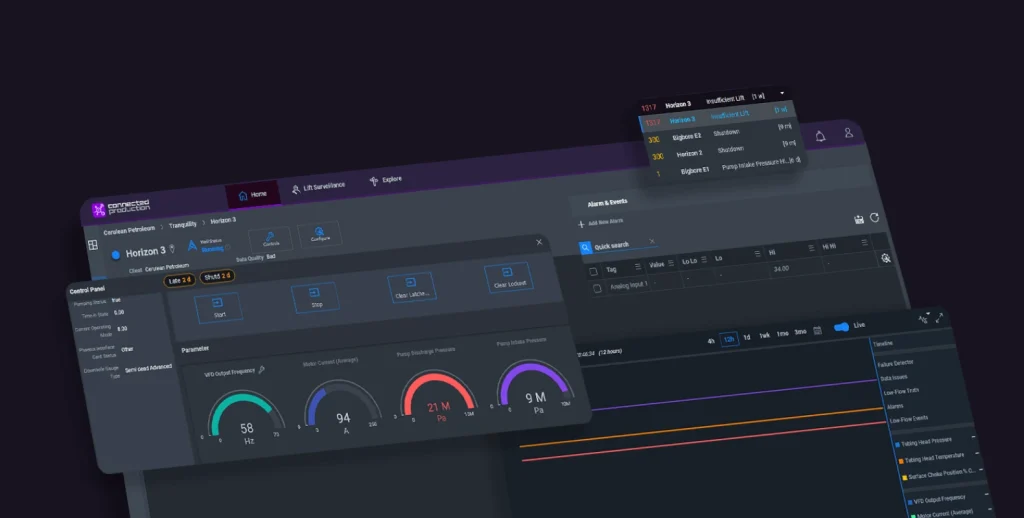We use cookies to ensure we give you the best experience on our website. By clicking Agree you accept our Privacy and Cookies Policy.
10 steps to digital transformation in the oil and gas industry

 11 minutes read
11 minutes read
Content
Are you a business owner in the oil and gas industry, looking to stay ahead of the digital transformation curve? If so, this article is for you! Digital transformation is becoming increasingly important in the oil and gas sector as technology advances. In this article, we’ll explore how your company can take steps to successfully transition into an ever-changing digital world. We’ll discuss the various challenges you may face, and provide advice on how to best address them. So, let’s get started!
Benefits of new technologies for oil and gas
New technologies are revolutionizing the oil and gas industry by improving safety, efficiency, environmental impact, data security, automation capabilities, connectivity and accuracy. Implementing these technologies will help companies stay competitive in an ever-changing market and keep their operations running smoothly for years to come. Let’s discuss it in more detail below.
Enhanced safety
New technologies are drastically improving safety in the oil and gas industry. For example, artificial intelligence (AI) is being used to detect anomalies and potential malfunctions before they occur, reducing human error and potential accidents. Additionally, these technologies can be used to automate hazardous processes, including tasks such as tanker truck loading that have traditionally been dangerous for workers.
Improved efficiency
Technologies such as automated systems help streamline production operations by eliminating manual labor where possible and providing real-time data on performance metrics. This enables companies to better plan ahead and make more informed decisions about resource management and operational efficiency.
Reduced environmental impact
There has been a push for more sustainable energy sources in recent years, and new technologies are helping this effort. For example, AI-powered predictive analytics can be used to reduce the amount of energy consumed in production processes by optimizing operations and identifying areas for improvement. Additionally, 3D printing is being deployed in the oil and gas industry to create lighter weight parts that require fewer raw materials.
Improved data security
Cybersecurity has become increasingly important in all industries—especially those dealing with sensitive data such as the oil and gas sector. New technologies have enabled companies to better protect their data from unauthorized access, while also enabling them to quickly detect and respond to potential threats before they become critical issues.
Increased automation
Automation has been around for a long time, but its use in the oil and gas industry has increased significantly in recent years. Automation can be used for a range of processes, from drilling to refining, allowing companies to increase their production capacity without compromising on quality or safety. Additionally, automation can help reduce costs by eliminating manual labor and increasing efficiency.
Improved connectivity
The internet of things (IoT) is enabling oil and gas companies to connect various components of their operations together, such as sensors and machines that are located around the world. By using this data, they can gain insights into how their systems are performing and make real-time adjustments to optimize operations. This improved connection also allows them to quickly respond to changes in the market or customer demands.
Improved accuracy
New technologies, such as drones and ground-penetrating radar (GPR), are being used to provide accurate data on geological surveys and other activities. This data can be used to better plan operations, reduce risks, and improve efficiency. Additionally, advanced analytics can be used to identify patterns or insights that would otherwise have gone unnoticed.

When it’s time to modernize your oil and gas software
If you want to modernize your oil and gas software, there are a few key problems that need to be addressed. These include:
Outdated Systems
Many of the existing systems used in the oil and gas industry are outdated and no longer meet industry standards in terms of accuracy, efficiency, or safety. Upgrading your system is essential to ensure that it meets current operational requirements.
Costly Maintenance
As with any system, regular maintenance is necessary for optimal performance. However, due to its age and complexity, maintaining an oil and gas software can be costly – both financially as well as in terms of time spent. Modernizing your software will help reduce these costs significantly.
Security Risks
As technology advances, so do the threats of cyber-attacks and data breaches. Outdated systems are particularly vulnerable due to their lack of security features. Upgrading your system with modern solutions will help protect sensitive information from malicious actors.
Inadequate Analytics
In order to make informed decisions about the business, you need access to accurate and up-to-date analytics. However, many existing oil and gas software solutions do not offer the necessary tools or insights for a detailed analysis. Modernizing your system can provide you with robust analytics that provide clear insight into operations.
Compatibility Issues
Many of the existing oil and gas software systems are not compatible with modern hardware or other industry-standard programs, limiting their usability and causing increased operational delays. Upgrading your system to a more up-to-date version will ensure that it runs smoothly alongside newer technologies.
Poor User Interface
Outdated user interfaces can be difficult to navigate and understand, making it hard for employees to use the software efficiently. Modernizing your system’s interface can help improve productivity by providing users with an intuitive platform for their tasks.
Insufficient Functionality
Even if a system is relatively new, its features might be too limited to meet the demands of current operations. By upgrading to a newer version, you can ensure that your software has the comprehensive functionality necessary for optimal performance and scalability.
Data Storage Limitations
Many older systems do not provide adequate storage space needed to store large amounts of data, resulting in decreased productivity due to time spent transferring or deleting files. Modernizing your system with a robust storage solution will increase efficiency by eliminating these issues.
Lack of Support
If you are using an outdated software system, it might be difficult to find relevant technical support if something goes wrong. Upgrading your system can help guarantee access to knowledgeable professionals who can provide assistance when needed.
By addressing these key points, updating your oil and gas software can help optimize performance, reduce costs, increase security, and improve decision making – ensuring your business remains competitive in the market.

Your digital transformation roadmap
By leveraging these approaches to legacy software and process modernization, you will be able to quickly and seamlessly transition from traditional systems to modern digital solutions. This will enable you to remain competitive and meet the demands of a rapidly changing market.
Approaches to legacy software & process modernization
1. Cloud migration
Moving your existing software and processes over to the cloud is a great way of modernizing them. Cloud migration can help you reduce costs, increase scalability, and improve performance. It also offers better security so that your data is safe from malicious attacks.
2. Artificial Intelligence (AI)
AI can be used to automate tasks and make decisions based on data-driven insights. This approach works best when there’s complex data analysis involved or when machine learning algorithms are needed for predictive analytics.
3. Automated processes
Automating manual processes is a great way to streamline operations in the oil and gas industry by reducing the need for human labor, saving time and money on tedious tasks like data entry and document processing.
4. Low-Code platforms
Low-code platforms can be used to deploy a digital transformation roadmap without the need for extensive coding or development work. This approach can help you build new software applications quickly and easily, while allowing you to maintain control of your budgets and timelines.
5. Internet of Things (IoT)
Connected sensors, devices, and machines in the oil and gas industry can be integrated with existing systems to improve performance monitoring and asset tracking. IoT solutions can also be used for predictive maintenance, ensuring that equipment is running at peak efficiency with minimal downtime.
6. Robotic Process Automation (RPA)
RPA can be used to automate repetitive tasks, such as data entry or document processing, with minimal human intervention. This technology is especially useful for large-scale operations that would otherwise require significant manual labor or expensive software development work. By using RPA, you can reduce costs while improving accuracy and productivity.
7. Data analytics
Leveraging data analytics tools and techniques can help you gain insights into your customer base, operations, or any other area related to your business’s success. This approach can be used to optimize processes, uncover new opportunities for growth, and make better decisions.
8. DevOps
DevOps is an approach that combines software development (Dev) and IT operations (Ops). This allows you to streamline your software delivery process by automating tasks such as testing and deployment. It also helps reduce costs and improve the reliability of your applications.
9. API integration
APIs are a great way to connect disparate systems together, allowing data to flow more freely between different applications or services. Integrating existing systems with modern solutions via API can help you build powerful digital experiences quickly and efficiently without having to do extensive coding work.

10 steps to digital transformation in the oil and gas industry
1. Define your goals
Start by defining your digital transformation roadmap objectives to identify the areas that need improvement and how they can be implemented. Identify core challenges, current gaps, and opportunities for growth within the oil and gas industry.
2. Gather information
Conduct research on existing technologies and gather data about customer needs, trends in the market, operational cost savings, etc., that will help inform your strategy.
3. Implement a cloud platform
Move legacy systems to the cloud platform to enhance scalability and reliability while reducing costs associated with maintaining hardware infrastructure such as servers or storage devices. This move will also help you take advantage of new features available in modern cloud-based solutions.
4. Enhance data management
Improve data quality and accessibility by transitioning to a unified data platform that supports integration with existing legacy systems. This will ensure the right data can be collected, analyzed, and utilized for business decisions.
5. Automate processes
Leverage AI capabilities to automate routine tasks and facilitate deeper insights into customer behavior to inform decision-making. Develop AI-driven solutions for predictive analytics, data mining, and other analytical activities.
6. Strengthen security measures
Leverage AI capabilities to automate routine tasks and facilitate deeper insights into customer behavior to inform decision-making. Develop AI-driven solutions for predictive analytics, data mining, and other analytical activities.
7. Utilize Artificial Intelligence (AI)
Leverage AI capabilities to automate routine tasks and facilitate deeper insights into customer behavior to inform decision-making. Develop AI-driven solutions for predictive analytics, data mining, and other analytical activities.
8. Enable mobility
Track progress throughout the transformation process by implementing key performance indicators (KPIs) to measure success against your goals. This will help you identify areas of improvement and adjust strategies accordingly.
9. Measure your progress
Track progress throughout the transformation process by implementing key performance indicators (KPIs) to measure success against your goals. This will help you identify areas of improvement and adjust strategies accordingly.
10. Evaluate results
Finally, evaluate results from the digital transformation roadmap initiatives to gain insights into how successful they have been in improving business operations, customer experience, etc., over time. Utilize customer feedback to further refine strategies and optimize the roadmap.
By following these steps, you will be well on your way to successfully modernizing software for the oil and gas industry.

Legacy application modernization for oil and gas: our experience
Our team at Blackthorn Vision recently helped a major US oil and gas company — Sensia — modernize their legacy application. The goal was to provide a web-based solution for monitoring equipment and collecting data in real-time, reliably and with minimal resources. Working closely with the client, our team developed an automated system that provided the needed data quickly and accurately.
The end result was an efficient system that has already yielded significant returns for this oil and gas firm. Not only were they able to reduce manual labor associated with monitoring equipment, but they’re also now able to gain more insights from the collected data by analyzing it faster than ever before. This new technology upgrade put them far ahead of their competitors in terms of operational productivity and reliability.
We’re proud to have delivered this successful project for our client, and we can do the same for your company. Reach out to Blackthorn Vision today to find out how our experienced team can help modernize your legacy applications! We’ll ensure that you get the most value out of every step of the process.






























































